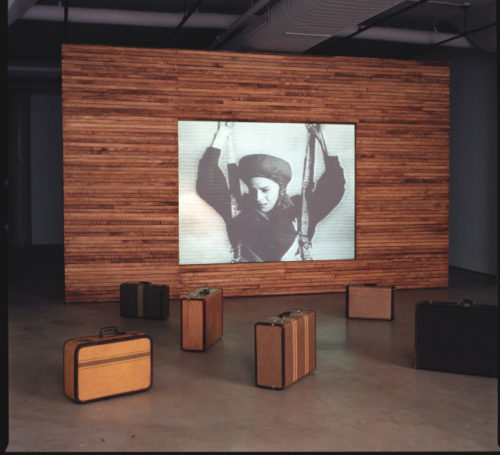
Every little breeze seems to whisper Louise
Birds in the trees seem to twitter Louise
Each little rose tells me it knows I love you
— Lyrics from Louise, sung by Maurice Chevalier
An examination of the ephemeral presence of women spys during World War II, this interactive project was shaped from stories of British women’s resistance and assumed identities.
Little Breeze is an evolving installation work by Toronto artist Nina Levitt about the ephemeral presence of women spies during World War II. The first iteration of the exhibition featured vintage suitcases embedded with audio speakers and electronics, and a large video projection controlled by a computer. Two new components were added to the work in the spring of 2004. The wall housing the projection screen, was re-designed to using wooden laths to reference interior walls of buildings. The effect is architecturally evocative of a previous era and allows viewers to peer through into the area that was previously “off limits”. Installed in a separate smaller room is another new aspect for the show: portraits of nine British agents, biographical texts printed to reference teletype ribbons and an interactive sound track.
Viewers are encouraged to become active participants in the gathering of (audio) information and the decoding of (video) images. The installation temporarily transports users into an experience of migration and dislocation. Through an intimate and tactile relationship with the technology, the viewer’s experience and imagination ultimately shapes the layers of imagery, language and metaphor in “Little Breeze”.
The work centres around the experiences of British agent Violette Szabo, code named “Louise” who at the age of 23 was sent into Occupied France for two missions, and was captured and executed just a few months before the end of the war. The subjects are women whose contributions to the war effort might seem ordinary or inconsequential, rather than the stereotype of a female agent like Mata Hari or the fictional James Bond femme fatale.
Description: Entering the gallery, visitors see a large video projection of a sequence of portraits of women made of ASCII (ask-ee) code. Eight vintage suitcases are huddled nearby. Picking up a suitcases triggers sound clips to play through a small speaker near the handle. Audio clips are from a feature film based on
British agent, Violette Szabo (called “Carve Her Name with Pride”, 1954). Opening a suitcase triggers the corresponding video clip to emerge from the field of ASCII code. Closing the suitcase causes the videos to morph into each other creating a 3-dimensional image that eventually reverts back into the series of portraits. Suitcases are left in the gallery wherever visitors are finished using them. In a small room nearby is an installation of audio, text and photographs. Hidden in the wall is a webcam that monitors a viewers presence. Entering the space, a viewer will hear a radio broadcast of Morse code. The viewer’s movement in the room causes a translation of the code to be revealed; the song “Louse” (sung by Maurice Chevalier) emerges from the code. If a viewer stops moving in the room, the song disappears back into the Morse code soundtrack. The teletype-like stripes of text circle the room, punctuated by small photographs, are short biographies of nine British agents who worked in Occupied France as secret agents.
Essay accompanying exhibition: Unfolding Memory by Kim Simon, published by the Doris McCarthy Gallery, Toronto, November 2004.
Little Breeze was first produced in co-operation with the Banff Centre, Banff Alberta, for the exhibition “Finding
Camp X: Contemporary Considerations of an Enigma” at the Robert McLaughlin Gallery, Oshawa, 2002 with
funding from the Canada council, the Faculty of Communication & Design at Ryerson University, the Ontario
Arts Council and the Toronto Arts Council.
Rental and Sales
Curators and programmers, please contact distribution@vtape.org to receive a login and password to preview Vtape titles online.
Screening and exhibition rentals and archival acquisitions include public performance rights; educational purchases or licenses include rights for classroom screenings and library circulation. When placing an order the customer agrees to our general online terms and conditions. Payment (or a purchase order number) and a signed licensing agreement must be received before media can be shipped to the client.
